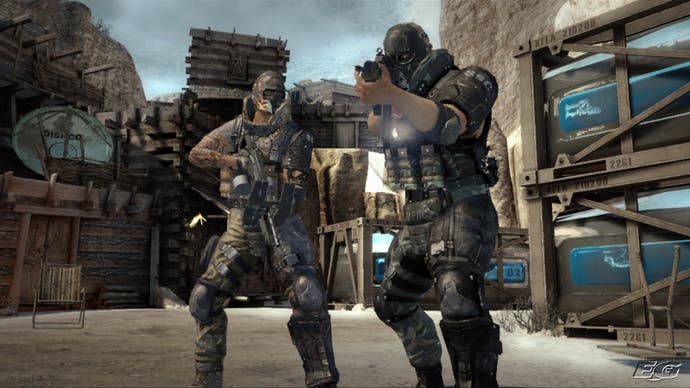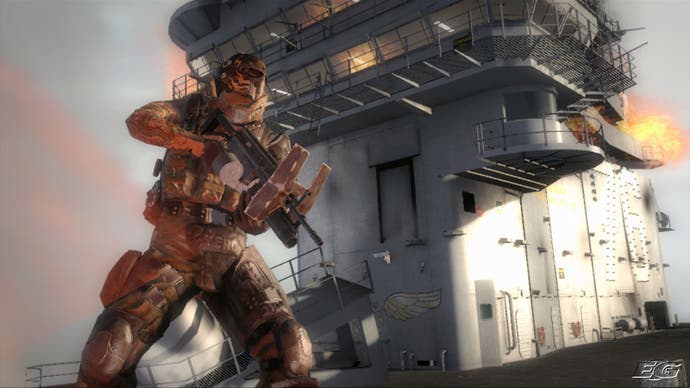Army of Two
Live together, die less, experience greater combat variety.
With Army of Two, EA Montreal believes it's struck on something that even the best co-operative shooters - like Gears of War and Rainbow Six Vegas - are missing out on: designing for co-op from the ground up. What that gives you is systems like Aggro - borrowed from MMOs, Aggro is the concept of drawing enemy attention in order to let your partner slip around unmolested.
Our recent first impressions gave us a taste of how we'll co-operate - with specific moves that bring players together to achieve shared goals, or to adopt new tactical approaches to each scenario - but we still had some questions.
Fortunately we managed to track down lead designer Chris Ferriera by phoning him up on the number he gave us, whereupon he told us how the game's seemingly disparate co-op systems, customisation options and level design themselves co-operate to give players an experience that not only encourages them to play together, but gives them more combat options than anything we've played before.

The whole studio was initially founded around the idea of a co-op game. The original design was to create a new genre - the genre of the pure co-op game, of everything being focused on two players from the ground up. The first things we looked at were just navigating a world - how can two guys move objects, and work with each other, and still have this interaction where they have to communicate in order to get these things done, rather than just playing sort of linked animations?
On top of that, we asked ourselves what will sell the most, what can we apply this to that's very popular right now? The market's flooded with shooters, but we felt that co-op is the one area where we can innovate. The shooter genre, we feel, is capped - even if you look at games like the new Call of Duty, it's beautiful and they've honed and perfected everything that's there, but what's new? What's the new innovation in gameplay?
For sure. Every aspect of the game, from the gameplay to the levels, and even the AI to your inventory weapon and customisation thing, is based around two players communicating with one another.
The biggest challenge we have is this communication thing. Often it's like, 'I need you to be here at this exact time so we can open a door together'. Instead, we say 'you're the other half of my gameplay - I'm doing one mechanic and you're actually the other half, so we need to communicate and we need to work together'.
It's existed in other areas - we're not revolutionising every aspect of co-op. We've got this co-op snipe, where two people shoot the same target. We felt that we could communicate that better, so we do a split-screen. If I'm on my couch, you're on your couch, when I call this mechanic and you join me, I'll get a three-window split - I'll get my view, your view, and the view around me. I know what you're targeting, so I can tell you: I have the guy on the right, you have the guy on the left. With that little bit of information that's conveyed - what the other player's looking at - it makes it that much easier.
When you remove those barriers and get the two people talking, and communicating, it makes the game that much more fun and allows them to co-operate easier, and I think that's thing - the ease of communication, and that need to communicate.

We're still tackling that issue today! A good example is with the Aggro system. In Rainbow Six Vegas, there's always someone who runs ahead, that knows the map and gets all the kills, and you're like 'Well why do I even play with you?' In our game the person that does that is going to build up all the Aggro and they're going to get cut down really fast.
The thing is that it's our job to tell that player, 'Listen, the game wasn't too hard, the tuning wasn't off, the AI wasn't that difficult - the problem was you weren't playing co-operatively.' We have a very smart tutorial at the beginning of the game and it introduces you to the characters and the world setting as well, unveiling the world as it explains the communication between the two of you.
Normally we'd do an insertion at the beginning. In Afghanistan we showed the parachute mechanic. In other missions you start in a vehicle - we do a couple where you insert on a hovercraft, and these are on water or on land, or transition between the two. Sometimes you insert in a jeep. So players start out in something that's familiar, where one's driving and one's shooting, and get a feel for the land and an eye for the enemies, and then we put you in on foot.
Once you're in the mission on foot, it's a very linear mission, but the way it works is that there's a linear channel into what we call a playground, which is a large open area, and then a channel to the next. In each of these open areas, it's easier for the AI to move around and it's easier for you to manipulate the Aggro, so every time you get to one of these playgrounds that's where the differentiation of play comes in. That's where a lot of the co-op mechanics exist. There might be a riot shield [one player uses a car door to protect the other from fire as they move around together] option, for instance. The way the enemies are brought around that area, as well as with the junctions, also differentiates.
And the different way it plays the Aggro. Say that you're at one end of the map and the objective's at the other. Do you both rush the objective? Does one person pull the attention away so one can stealth around and get it? Do you both play it in the middle like a standard shooter? Do you use a different co-op mechanic to navigate vertically, to get the advantage on the enemy and split up that way? The risk there of course is that if you die above me, I can't get to you, but sometimes that's a risk you take, so it's sort of a risk-reward of how you play.
On top of that it's also who you're playing with, how experienced they are - and how good is their equipment? Because those three things are going to change your play-through every single time.



